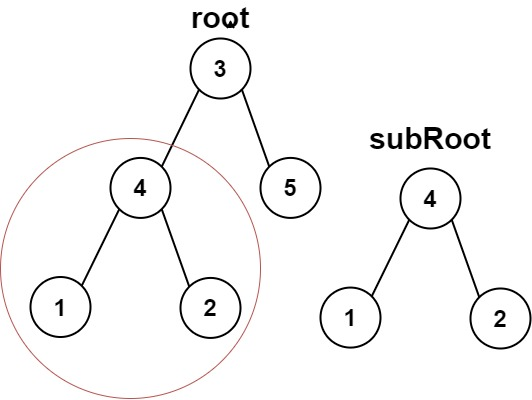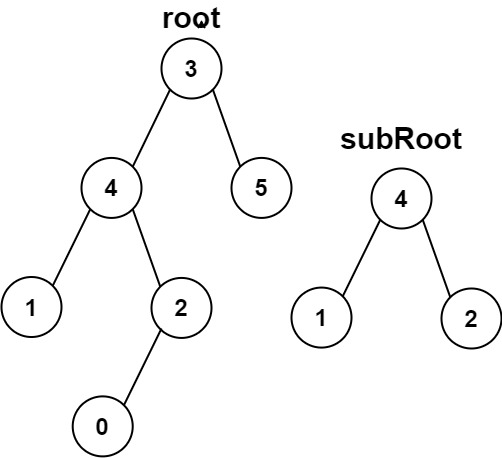二叉树
哈希函数
字符串匹配
树
深度优先搜索
题目描述
给你两棵二叉树 root 和 subRoot 。检验 root 中是否包含和 subRoot 具有相同结构和节点值的子树。如果存在,返回 true ;否则,返回 false 。
二叉树 tree 的一棵子树包括 tree 的某个节点和这个节点的所有后代节点。tree 也可以看做它自身的一棵子树。
示例 1:
输入: root = [3,4,5,1,2], subRoot = [4,1,2]
输出: true
示例 2:
输入: root = [3,4,5,1,2,null,null,null,null,0], subRoot = [4,1,2]
输出: false
提示:
root 树上的节点数量范围是 [1, 2000]subRoot 树上的节点数量范围是 [1, 1000]-104 <= root.val <= 104 -104 <= subRoot.val <= 104
解法
方法一:DFS
我们定义一个辅助函数 \(\textit{same}(p, q)\) ,用于判断以 \(p\) 为根节点的树和以 \(q\) 为根节点的树是否相等。如果两棵树的根节点的值相等,并且它们的左子树和右子树也分别相等,那么这两棵树是相等的。
在 \(\textit{isSubtree}(\textit{root}, \textit{subRoot})\) 函数中,我们首先判断 \(\textit{root}\) 是否为空,如果为空,则返回 \(\text{false}\) 。否则,我们判断 \(\textit{root}\) 和 \(\textit{subRoot}\) 是否相等,如果相等,则返回 \(\text{true}\) 。否则,我们递归地判断 \(\textit{root}\) 的左子树和右子树是否包含 \(\textit{subRoot}\) 。
时间复杂度 \(O(n \times m)\) ,空间复杂度 \(O(n)\) 。其中 \(n\) 和 \(m\) 分别是树 \(root\) 和树 \(subRoot\) 的节点个数。
Python3 Java C++ Go TypeScript Rust JavaScript
1
2
3
4
5
6
7
8
9
10
11
12
13
14
15
16
17
18
19
20 # Definition for a binary tree node.
# class TreeNode:
# def __init__(self, val=0, left=None, right=None):
# self.val = val
# self.left = left
# self.right = right
class Solution :
def isSubtree ( self , root : Optional [ TreeNode ], subRoot : Optional [ TreeNode ]) -> bool :
def same ( p : Optional [ TreeNode ], q : Optional [ TreeNode ]) -> bool :
if p is None or q is None :
return p is q
return p . val == q . val and same ( p . left , q . left ) and same ( p . right , q . right )
if root is None :
return False
return (
same ( root , subRoot )
or self . isSubtree ( root . left , subRoot )
or self . isSubtree ( root . right , subRoot )
)
1
2
3
4
5
6
7
8
9
10
11
12
13
14
15
16
17
18
19
20
21
22
23
24
25
26
27
28
29
30
31 /**
* Definition for a binary tree node.
* public class TreeNode {
* int val;
* TreeNode left;
* TreeNode right;
* TreeNode() {}
* TreeNode(int val) { this.val = val; }
* TreeNode(int val, TreeNode left, TreeNode right) {
* this.val = val;
* this.left = left;
* this.right = right;
* }
* }
*/
class Solution {
public boolean isSubtree ( TreeNode root , TreeNode subRoot ) {
if ( root == null ) {
return false ;
}
return same ( root , subRoot ) || isSubtree ( root . left , subRoot )
|| isSubtree ( root . right , subRoot );
}
private boolean same ( TreeNode p , TreeNode q ) {
if ( p == null || q == null ) {
return p == q ;
}
return p . val == q . val && same ( p . left , q . left ) && same ( p . right , q . right );
}
}
1
2
3
4
5
6
7
8
9
10
11
12
13
14
15
16
17
18
19
20
21
22
23
24
25
26
27 /**
* Definition for a binary tree node.
* struct TreeNode {
* int val;
* TreeNode *left;
* TreeNode *right;
* TreeNode() : val(0), left(nullptr), right(nullptr) {}
* TreeNode(int x) : val(x), left(nullptr), right(nullptr) {}
* TreeNode(int x, TreeNode *left, TreeNode *right) : val(x), left(left), right(right) {}
* };
*/
class Solution {
public :
bool isSubtree ( TreeNode * root , TreeNode * subRoot ) {
if ( ! root ) {
return false ;
}
return same ( root , subRoot ) || isSubtree ( root -> left , subRoot ) || isSubtree ( root -> right , subRoot );
}
bool same ( TreeNode * p , TreeNode * q ) {
if ( ! p || ! q ) {
return p == q ;
}
return p -> val == q -> val && same ( p -> left , q -> left ) && same ( p -> right , q -> right );
}
};
1
2
3
4
5
6
7
8
9
10
11
12
13
14
15
16
17
18
19
20
21 /**
* Definition for a binary tree node.
* type TreeNode struct {
* Val int
* Left *TreeNode
* Right *TreeNode
* }
*/
func isSubtree ( root * TreeNode , subRoot * TreeNode ) bool {
var same func ( p , q * TreeNode ) bool
same = func ( p , q * TreeNode ) bool {
if p == nil || q == nil {
return p == q
}
return p . Val == q . Val && same ( p . Left , q . Left ) && same ( p . Right , q . Right )
}
if root == nil {
return false
}
return same ( root , subRoot ) || isSubtree ( root . Left , subRoot ) || isSubtree ( root . Right , subRoot )
}
1
2
3
4
5
6
7
8
9
10
11
12
13
14
15
16
17
18
19
20
21
22
23
24
25 /**
* Definition for a binary tree node.
* class TreeNode {
* val: number
* left: TreeNode | null
* right: TreeNode | null
* constructor(val?: number, left?: TreeNode | null, right?: TreeNode | null) {
* this.val = (val===undefined ? 0 : val)
* this.left = (left===undefined ? null : left)
* this.right = (right===undefined ? null : right)
* }
* }
*/
function isSubtree ( root : TreeNode | null , subRoot : TreeNode | null ) : boolean {
const same = ( p : TreeNode | null , q : TreeNode | null ) : boolean => {
if ( ! p || ! q ) {
return p === q ;
}
return p . val === q . val && same ( p . left , q . left ) && same ( p . right , q . right );
};
if ( ! root ) {
return false ;
}
return same ( root , subRoot ) || isSubtree ( root . left , subRoot ) || isSubtree ( root . right , subRoot );
}
1
2
3
4
5
6
7
8
9
10
11
12
13
14
15
16
17
18
19
20
21
22
23
24
25
26
27
28
29
30
31
32
33
34
35
36
37
38
39
40
41
42
43
44
45
46
47
48
49
50
51
52 // Definition for a binary tree node.
// #[derive(Debug, PartialEq, Eq)]
// pub struct TreeNode {
// pub val: i32,
// pub left: Option<Rc<RefCell<TreeNode>>>,
// pub right: Option<Rc<RefCell<TreeNode>>>,
// }
//
// impl TreeNode {
// #[inline]
// pub fn new(val: i32) -> Self {
// TreeNode {
// val,
// left: None,
// right: None
// }
// }
// }
use std :: cell :: RefCell ;
use std :: rc :: Rc ;
impl Solution {
pub fn is_subtree (
root : Option < Rc < RefCell < TreeNode >>> ,
sub_root : Option < Rc < RefCell < TreeNode >>> ,
) -> bool {
if root . is_none () {
return false ;
}
Self :: same ( & root , & sub_root )
|| Self :: is_subtree (
root . as_ref (). unwrap (). borrow (). left . clone (),
sub_root . clone (),
)
|| Self :: is_subtree (
root . as_ref (). unwrap (). borrow (). right . clone (),
sub_root . clone (),
)
}
fn same ( p : & Option < Rc < RefCell < TreeNode >>> , q : & Option < Rc < RefCell < TreeNode >>> ) -> bool {
match ( p , q ) {
( None , None ) => true ,
( Some ( p ), Some ( q )) => {
let p = p . borrow ();
let q = q . borrow ();
p . val == q . val && Self :: same ( & p . left , & q . left ) && Self :: same ( & p . right , & q . right )
}
_ => false ,
}
}
}
1
2
3
4
5
6
7
8
9
10
11
12
13
14
15
16
17
18
19
20
21
22
23
24
25 /**
* Definition for a binary tree node.
* function TreeNode(val, left, right) {
* this.val = (val===undefined ? 0 : val)
* this.left = (left===undefined ? null : left)
* this.right = (right===undefined ? null : right)
* }
*/
/**
* @param {TreeNode} root
* @param {TreeNode} subRoot
* @return {boolean}
*/
var isSubtree = function ( root , subRoot ) {
const same = ( p , q ) => {
if ( ! p || ! q ) {
return p === q ;
}
return p . val === q . val && same ( p . left , q . left ) && same ( p . right , q . right );
};
if ( ! root ) {
return false ;
}
return same ( root , subRoot ) || isSubtree ( root . left , subRoot ) || isSubtree ( root . right , subRoot );
};


